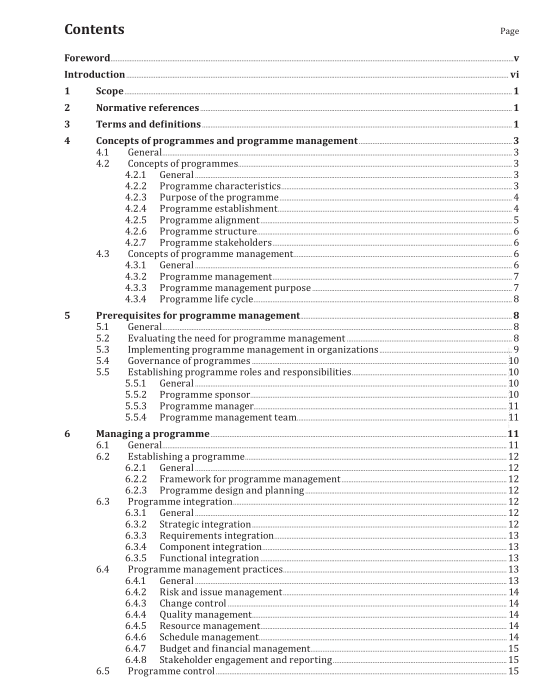ISO 21503:2022 pdf download.Project, programme and portfolio management — Guidance on programme management.
This document gives guidance on programme management. It is applicable to any type of organization including public or private and any size or sector, as well as any type of programme in terms of complexity.
This document provides high-level descriptions of relevant terms, definitions, concepts, prerequisites and practices, including roles and responsibilities that form good practice in programme management.
It does not provide guidance on processes, methods and tools.
2 Normative references
There are no normative references in this document.
3 Terms and definitions
For the purposes of this document, the following terms and definitions apply.
ISO and IEC maintain terminological databases for use in standardization at the following addresses:
— ISO Online browsing platform: available at https:// www .iso .org/ obp
— IEC Electropedia: available at https:// www .electropedia .org/
3.1 baseline
reference basis for comparison against which performance is monitored and controlled [SOURCE: ISO/TR 21506:2018, 3.5]
3.2 benefit
created advantage, value or other positive effect [SOURCE: ISO/TR 21506:2018, 3.6]
3.3 deliverable
unique and verifiable element that is required to be produced by a project (3.14) or programme (3.10) [SOURCE: ISO 21502:2020, 3.9, modified — “or programme” has been added.]
3.4 governance
principles, policies and framework by which an organization is directed and controlled [SOURCE: ISO/TR 21506:2018, 3.25]
3.5 governing body
person, group or entity accountable for the governance (3.4) of an organization, organizations or a part of an organization
[SOURCE: ISO/TR 21506:2018, 3.26]
3.6 outcome
change resulting from the use of the output (3.7) from a project (3.14) or programme (3.10)
[SOURCE: ISO 21502:2020, 3.13, modified — “or programme” has been added.]
3.7 output
aggregated tangible or intangible deliverables (3.3) that form the project (3.14) or programme (3.10) result
[SOURCE: ISO 21502:2020, 3.14, modified — “or programme” has been added.]
3.8 portfolio
collection of portfolio components (3.9) grouped together to facilitate their management to meet strategic objectives
[SOURCE: ISO/TR 21506:2018, 3.42]
3.9 portfolio component
project (3.14), programme (3.10), portfolio (3.8), or other related work [SOURCE: ISO/TR 21506:2018, 3.43]
3.10 programme
group of programme components (3.12) managed in a coordinated way to realize benefits (3.2) [SOURCE: ISO/TR 21506:2018, 3.50]
3.11 programme benefit
assessable outcome (3.6) by managing interrelated programme components (3.12) together to achieve strategic and operational objectives
[SOURCE: ISO/TR 21506:2018, 3.51, modified — “by managing interrelated programme components together to achieve strategic and operational objectives” has replaced “viewed as an advantage by programme stakeholders and contributing to the programme objectives”.]
3.12 programme component
project (3.14), programme (3.10) or other related work [SOURCE: ISO/TR 21506:2018, 3.52]
3.13 programme management
coordinated activities to direct and control the realisation of identified benefits (3.2) and deliverables (3.3)
[SOURCE: ISO/TR 21506:2018, 3.54]
4 Concepts of programmes and programme management
4.1 General
This clause describes the concepts of programmes and programme management. It provides guidance to executive and senior management on how programme management should be integrated in an organization or organizations.
4.2 Concepts of programmes
4.2.1 General
This subclause describes the concept of programmes, and describes a programme’s purpose,establishment, alignment, structure and stakeholders.
4.2.2 Programme characteristics
Programmes can be strategic, transformational or operational, and have one or more of the following characteristics:
— programmes comprise programme components that have interdependent and interrelated relationships to one another;
— programmes provide outcomes and benefits for stakeholders and contribute to strategic,transformational or operational objectives;
— programmes have complexity and uncertainty, which need to be managed and reduced where possible.
Complexity and uncertainty in relation to programmes can include:
— unclear and uncertain objectives to be achieved;
— context and other external factors;
— social, political, economic, sustainability and legal dynamics;
— technological aspects;
— constraints, such as time, cost, quality and risks;
— interdependencies and integration among the programme components;
— logistical issues;
— stakeholders’ diverse viewpoints and expectations.
4.2.3 Purpose of the programme
The purpose of the programme should be to deliver outcomes and realize benefits, which are aligned to strategic and operational objectives, that cannot be realized when components are managed individually. The programme can also have objectives, such as improving efficiency, reducing threats and realizing opportunities.
4.2.4 Programme establishment
When establishing a programme, activities that should be considered include:
— developing a common approach to managing programme components;
— managing stakeholders’ views and interests (see 6.4.8);
— communicating internal and external aspects of the programme;
— improving benefits realization, particularly in scheduling the early realization of benefits (see 6.6);
— optimizing the use of resources across programme components (see 6.4.5);
— optimizing cost, schedule and quality (see 6.4.6, 6.4.7 and 6.4.4);
— managing the risks and issues of the programme (see 6.4.2);
— steering and aligning the programme components (see 6.4.2);
— supporting a business rationale, which defines the objectives of the programme;
— identifying benefits to be realized by managing the individual components as a programme (see 6.6);
— aligning with one or more of the strategic, transformational and operational objectives.ISO 21503 pdf download.ISO 21503:2022 pdf download
